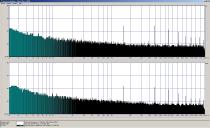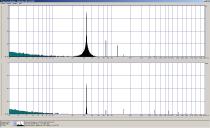
-
This is topic only about tests that include two or more different recorders, use specific topics for test including only one recorder
-
@sherwood Agreed- I always use (at a minimum) the FFT mode of SoundForge to examine the noise floor and distortion of a recorder, although these days most of the top-flight units tend to be pretty good. Microphones themselves can be quite a different proposition, however. I tend to stick with the Rode mics where noise floor is an issue. But the all-in-one recorders are so handy and lightweight, those are what I tend to carry around... :)
Here are typical Sound Forge FFT plots from one of my tiny Yamaha Pocketrak 2G recorders in 16bit mode :)

 Noise_floor_5.jpg1680 x 1026 - 167K
Noise_floor_5.jpg1680 x 1026 - 167K
 Distortion_6db_10L.jpg1680 x 1026 - 142K
Distortion_6db_10L.jpg1680 x 1026 - 142K -
"In any case, maximizing the dynamic range is not the goal. Recording your subject with acceptably low noise is the goal."
In practice, actually, it's both. But I'd agree that the pursuit of dynamic range at the expense of a noisy floor (caused by either poor mics, preamps or both) is not desirable. The Zoom H4N is a decent, usable device for certain things, and a bargain at the price. However, the Zoom's design is inherently cumbersome (hey, waddya want for $250?) and the mic preamps are far too noisy for the very things you'll have to record over and over again in a professional/serious project: dialogue, room ambience, foley etc. Apropos, these tests would be much more informative if they included extended segments of recorded silence.
-
-
@balazer Nonsense? Oh well - I do my best, based on professional audio experience accumulated over 40 years, based on my many designs for low-noise preamps, audio and digital processing units, and etc. Hopefully the information will be of use to somebody :)
And yes, if I had an ISO setting maximizing dynamic range on my camera - say ISO 100, for example, I would do my best to adjust shutter, aperture and lighting to try and hit that sweet spot of ISO 100. I think there are many here who would do the same :)
-
Trevmar, stop repeating nonsense. A gain setting of 37 on the Zoom H1 minimizes its equivalent internal noise. But dynamic range is a much different thing that also depends on the microphone, its sensitivity, max SPL, internal noise, and on quantization noise.
In any case, maximizing the dynamic range is not the goal. Recording your subject with acceptably low noise is the goal. If I told you the GH2 had some particular ISO setting that maximized the camera's dynamic range, would you always use that ISO setting? Of course not. You don't want to just maximize the range. You need to fit your subject within the range. Restricting yourself to one gain setting means you will sometimes have underexposure or overexposure.
-
The Zoom H1 has a 'sweet spot' when the recording gain is set to "37". Any values lower or higher reduce the dynamic range. I am not sure where the H4N has least noise, but I do know that the Zoom audio chain is pretty good, especially on the H1 and H2N.
http://zoomforum.us/viewtopic.php?f=15&t=15488&start=0
-
quick test with a Rode NTG2, Tascam DR-100 and Zoom H4N running into the GH2 (with Pasadena Pulse hack setting)
-
The Marantz and Roland sound very clean. The Zoom seemed to have the most noise of the bunch, but the brightest high end. All very workable recorders though!
Howdy, Stranger!
It looks like you're new here. If you want to get involved, click one of these buttons!
Categories
- Topics List23,993
- Blog5,725
- General and News1,354
- Hacks and Patches1,153
- ↳ Top Settings33
- ↳ Beginners256
- ↳ Archives402
- ↳ Hacks News and Development56
- Cameras2,368
- ↳ Panasonic995
- ↳ Canon118
- ↳ Sony156
- ↳ Nikon96
- ↳ Pentax and Samsung70
- ↳ Olympus and Fujifilm102
- ↳ Compacts and Camcorders300
- ↳ Smartphones for video97
- ↳ Pro Video Cameras191
- ↳ BlackMagic and other raw cameras116
- Skill1,960
- ↳ Business and distribution66
- ↳ Preparation, scripts and legal38
- ↳ Art149
- ↳ Import, Convert, Exporting291
- ↳ Editors191
- ↳ Effects and stunts115
- ↳ Color grading197
- ↳ Sound and Music280
- ↳ Lighting96
- ↳ Software and storage tips266
- Gear5,420
- ↳ Filters, Adapters, Matte boxes344
- ↳ Lenses1,582
- ↳ Follow focus and gears93
- ↳ Sound499
- ↳ Lighting gear314
- ↳ Camera movement230
- ↳ Gimbals and copters302
- ↳ Rigs and related stuff273
- ↳ Power solutions83
- ↳ Monitors and viewfinders340
- ↳ Tripods and fluid heads139
- ↳ Storage286
- ↳ Computers and studio gear560
- ↳ VR and 3D248
- Showcase1,859
- Marketplace2,834
- Offtopic1,320







